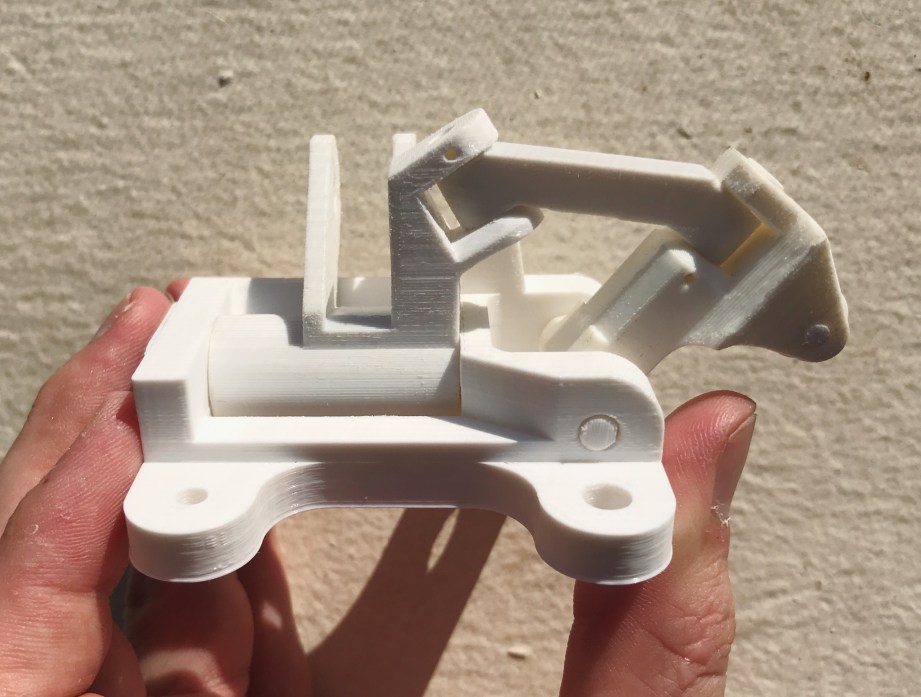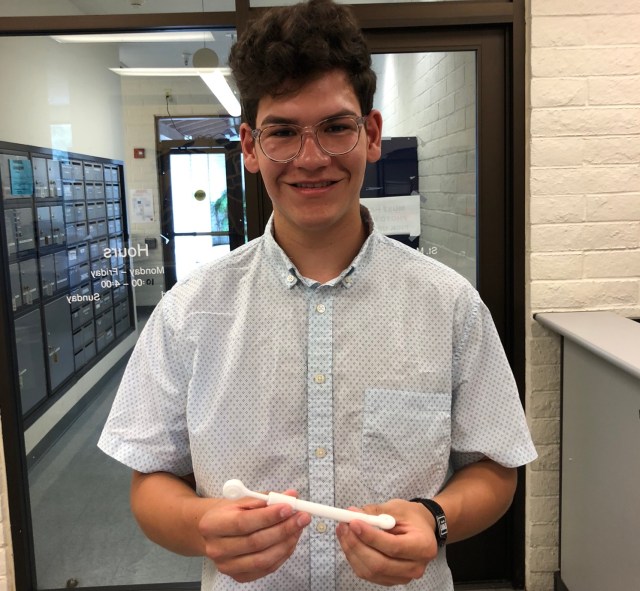Maker Chris Yohe took an authentic approach to his Project Egress part, using a hydrogen peroxide and vinegar mixture to make his latch look like it had been recovered from the depths of the ocean. Luckily, he had a great helper: his 3-year-old son Noah.
Continue on for Chris’ fascinating and deep description of his process.
Bio: Chris Yohe is a lifelong maker and digital fabricator extraordinaire. The longest running tester on Make:’s Digital Fabrication Testing team he’s been pushing the limits and punishing these machines for about a decade. He co-founded 3DPPGH, Pittsburgh PA’s premiere 3D Printing meetup, now in its fourth year. An evangelist for all kinds of technology., he enjoys sharing the love, wherever it leads him.
 PART #17: RIGHT HAND DOUBLE LATCH ASSEMBLY
PART #17: RIGHT HAND DOUBLE LATCH ASSEMBLY
Artist statement: “It’s not every day you get called up to work on a project with Jen Schachter (and, of course, Adam Savage) — both heroes of mine — so when the message came through I knew it was a definite yes. The question is then how to make your part worthy of the bigger whole, and so a little ruminating went towards what would make this little latch stand out.
Being a digital fabrication fanatic, 3D printing is often the go-to starting point for an easy rough draft, but I knew I wanted to incorporate other fabrication techniques. The pieces themselves seemed to lend themselves well to printing, but using other tools such as laser cutters, casting, etc., posed some challenges or weren’t great fits given the pieces.
In order to ensure a great result in the given time I settled on a three pronged approach, using unique 3D printing mediums to fabricate the intricate parts of the latch, manually fabricating the pins from stock, then using a CNC Mill to make the pin lock from aluminum and the roller from the standard Delrin.
For the 3D printed parts, ProtoPasta makes my go-to filaments for wow factor and their metal filled PLAs offer an amazing look with a variety of finishing techniques available. I printed the parts from three varieties, their carbon fibre, their stainless steel, and then their magnetic iron, to see the differences.
One of the benefits of these particular filaments is that they really hide the layer lines well, making them much harder to detect before any post processing with a nice matte finish. I chose to print at a low layer height (150 microns) and 60% infill, giving near the strength of solid parts, but saving time, filament, and weight. Hitting the metal filaments with a light sanding and buffing brings out a nice shine and further hides any lines.
Then thinking back towards memories of the space race growing up, visions of splash downs flashed in my mind and I remembered the iron filament could be rusted. Using a hydrogen peroxide and vinegar mixture, I was able in the course of 24 hours to make it look like the latch had been recovered from the depths. A simple process, requiring only a spray bottle and some patience, it really gave some personality to the latch.
While the printing was going on I turned to the tried and true Dremel to make the pins out of some standard stainless steel rod, and got to work machining the pin and roller. The pin lock was by far the more difficult, so I set out machining a couple of test pieces in wood on the Nomad to make sure the design and toolpaths were correct, and test fitted it this way. Much faster to find out it didn’t work in wood than aluminum.
From there it was a matter of some speeds and feeds adjustment (and trial and error) then we had three pin locks made, all nice and shiny. After the parts finished up I had everything I needed to get started with the final fittings. I enlisted the help of my trusty son Noah (already becoming quite the master of hand tools just shy of 3) and we began the process of squeezing and pressing and clamping everything in place.
Once the initial rusted latch was complete, we made a second backup one out of the carbon fibre parts – you never know when that important package will be lost, and they only seem to lose the important ones. One of the major takeaways from the process was the value in having made many spare parts, since in the process of assembly a few of the parts didn’t fit as smoothly as hoped, and a few failures occurred, especially where the tiny locking pins have to pass through multiple parts and line up just right. The other major takeaway is that all the hours spent toiling away and learning all of these tools and techniques are well worth it when you get to work as a small part of such an amazing group of luminaries and leaders.”
Follow Matt: Website | Instagram | Twitter









































